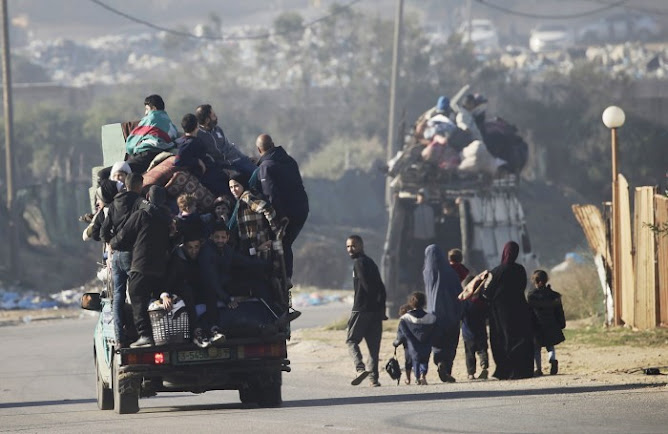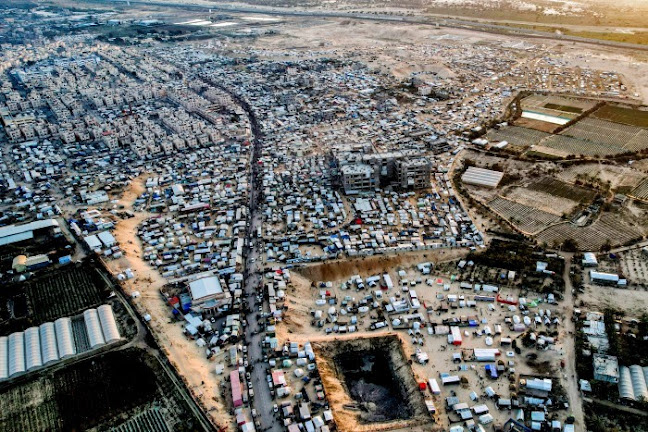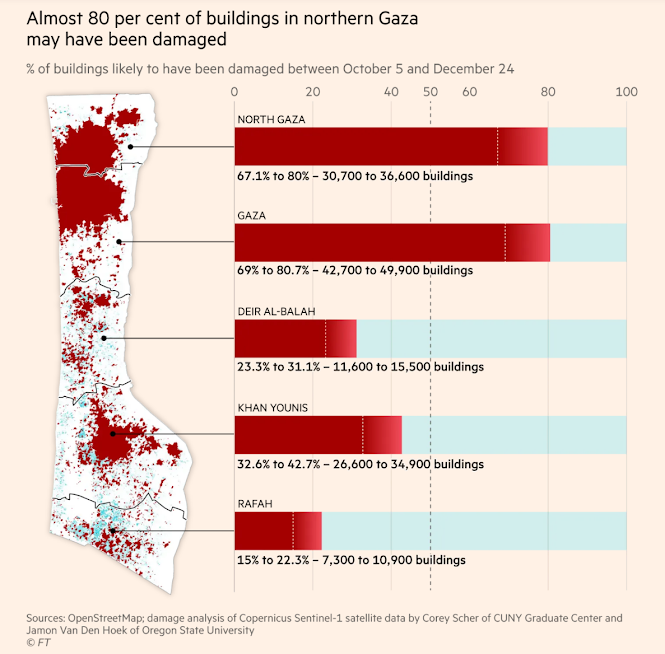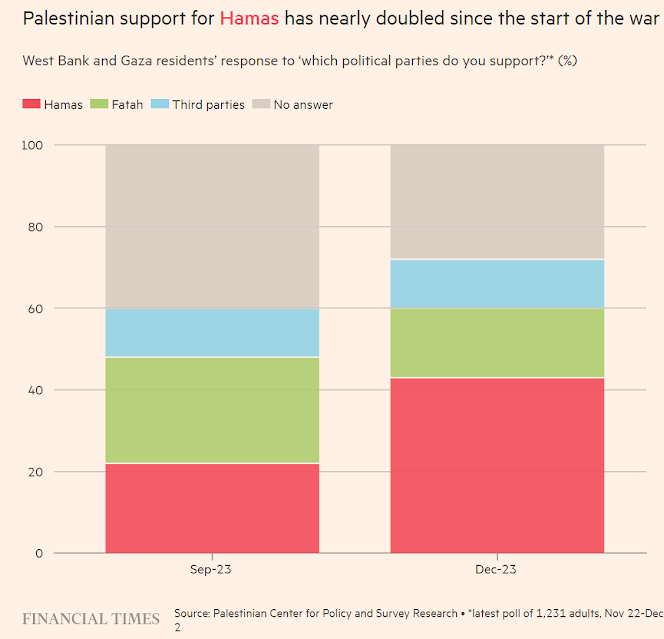What will be left of Gaza when the war ends?
The infrastructure and economy of the enclave have been shattered, and Gazans displaced by the conflict fear there will be nothing to return to
Andrew England in London, Heba Saleh in Cairo and Mai Khaled in Gaza
 An aerial view of destroyed buildings in Jabalia refugee camp in northern Gaza early in the conflict © Yahya Hassouna/AFP/Getty Images
An aerial view of destroyed buildings in Jabalia refugee camp in northern Gaza early in the conflict © Yahya Hassouna/AFP/Getty ImagesFaysal Shawa thought he had seen the best and worst of what life in Gaza had to offer.
As a young man three decades ago he was swept up in the giddy optimism as huge crowds packed into Gaza City to welcome the late Palestinian leader Yasser Arafat back from exile.
It was the summer of 1994, 10 months after Israel and the Palestine Liberation Organisation signed the Oslo Accords, a historic breakthrough many hoped would lead to a sustainable settlement of their decades-long conflict.
As a teary-eyed Arafat promised “a democratic and free homeland”, Gaza was briefly the base of Palestinian political power.
“Finally, we were no longer seeing Israeli soldiers on the ground in Gaza — it was amazing,” recalls Shawa.
The following year, armed with a degree in civil engineering from the US and support from his father, he set up a construction company, convinced Gaza would flourish.
For a brief few years it did.
But then the peace process collapsed, replaced by cycles of violence and costly recovery.
Still, Shawa clung to his hopes and continued to invest.
The construction business became a stepping stone to a larger empire that included brick and asphalt factories; housing developments; chicken, citrus fruit and olive farms; and an office block that bears his name.
The businesses endured through at least four wars between Israel and Hamas, the militant Islamist movement that has controlled Gaza since 2007.
Farms, factories and buildings were damaged, but each time he reinvested.
But today he is at his lowest ebb: forced from his home, angry and unable to fathom the catastrophic devastation wrought by Israeli bombs and bulldozers over the past three months.
“We lost our fortune; now we are refugees.
We don’t have our money and our land . . .
We cannot get our clothes from our home — all our investments, our factories,” Shawa says.
“Today everything is ruined.”
 Residents of Nuseirat and Al-Bureij refugee camps evacuate with their possessions after Israel issued a warning of increased military operations in the area on December 26 © © Mohammed Saber/EPA-EFE/Shutterstock
Residents of Nuseirat and Al-Bureij refugee camps evacuate with their possessions after Israel issued a warning of increased military operations in the area on December 26 © © Mohammed Saber/EPA-EFE/ShutterstockAll Gazans, rich and poor, young and old, are reeling from Israel’s relentless air and land offensive against Hamas in Gaza.
Virtually every family has lost a relative or friend as almost 22,000 people, mostly women and children, have been killed since Israel launched its war on October 7, according to Palestinian officials.
Beyond the surging death toll, it is the scale of devastation that has shaken Gazans.
All the elements that underpinned normal life in the territory — the schools, the libraries, the bakeries and other businesses — have been shattered.
Dazed and terrified, Gazans fear there will be nothing to return to when the guns finally fall silent.
Many conclude that Israel’s ultimate goal is to make the strip uninhabitable and force them to abandon the land they call home.
“They want to make Gaza unlivable,” says Shawa.
“Even if you allow us to go back tomorrow, how are we going to live?
They destroy our homes, our investments, our factories, our trees, infrastructure — everything.”
Some in the far-right government of prime minister Benjamin Netanyahu have suggested that Gazans could be voluntarily resettled, with finance minister Bezalel Smotrich telling Israel’s Army Radio at the weekend that if “there were 100,000-200,000 Arabs in the strip and not 2mn, the whole conversation about the day after [the war] would be completely different.”
His comments do not reflect official policy, but many Gazans suspect Israel wants to push them south into Egypt.
In the first weeks of the war, Netanyahu’s government sought to convince European leaders to pressure Egypt into accepting refugees from Gaza.
Cairo has vociferously warned it will not accept the forced displacement of Gazans on to its soil, but concerns linger and Palestinians fear a repeat of the 1948 nakba, or catastrophe, when some 700,000 of them were displaced following the first war between Arab states and the newly independent Israel.
About 1.7mn Gazans are descended from those who fled their homes 75 years ago, classified by the UN as refugees.
“People think, when is it going to end?
Will we go back?
Are they going to push us to the Sinai?” says Azmi Kishawi, Gaza researcher for the Crisis Group think-tank.
Several hundred Gazans, like Shawa, have escaped the carnage by leveraging foreign passports to cross into Egypt.
But most are homeless, trapped there with the strip’s borders sealed off by Israel’s siege.
Inside Gaza, more than 85 per cent of the 2.3mn population — almost half of which is aged under 18 — have been forced from their homes and squeezed into ever narrower areas of the south, taking sanctuary with whatever they could carry in overflowing apartment blocks, schools, hospitals, buildings used by the UN and tents.
A quarter of the population has been pushed towards starvation, according to the UN.
People queue for hours for bread or to use a toilet.
Many do not know if their homes are still standing.
Among the displaced is Mahmoud Rostom, a third year IT student at Gaza’s Islamic University, who fled Khan Younis, Gaza’s second-largest city, with his parents and nine siblings last month.
His family have heard that their house has been damaged, but they do not know how badly.
The university where he hoped to complete the final year of his studies has been bombed — Israel’s military said Hamas was using it as a “training camp for military intelligence operatives, as well as for the development and production of weapons”.
But it is the simple things that come to Rostom’s mind as he ponders his uncertain future: his destroyed bicycle, the bombed football pitch, his jogging partner who lost a leg when a bomb or artillery round struck near a hospital entrance.
“I won’t be able to run, how can I do that without my friend?” the 21-year-old says.
“Many things will not be like before.
I’m not the same as before.”
Gazans are no strangers to having to pick up the pieces of their lives amid ruins.
A fleeting moment of hope inspired by the Oslo Accords was shattered by the collapse of the peace process and the outbreak of a second intifada, or uprising, in 2000.
Much of the strip’s infrastructure was damaged or destroyed.
Gazans were banned from working in Israel and settlements, and the movement of goods into the enclave was severely restricted. Any lingering thoughts of Palestinian statehood were crushed.
Israel withdrew fully from the territory in 2005, but maintained control over its airspace and its borders, except for 12km bordering Egypt.
The following year, Hamas won Palestinian elections and in 2007 ousted Fatah, a rival faction that dominates the Palestinian Authority, from the strip.
In response, Israel imposed a blockade that has choked the economy ever since.
 A boy harvests olives during the temporary ceasefire in November. Since then, Israeli strikes have hit vital infrastructure, leaving the territory’s farms damaged or abandoned © © Majdi Fathi/NurPhoto
A boy harvests olives during the temporary ceasefire in November. Since then, Israeli strikes have hit vital infrastructure, leaving the territory’s farms damaged or abandoned © © Majdi Fathi/NurPhotoBetween 2006 and 2022, Gaza’s real gross domestic product per capita shrank by 27 per cent to $1,257, according to Unctad, the UN body for trade and development.
When the latest war erupted, more than three-quarters of the population were dependent on international aid and unemployment was about 44 per cent.
Yet somehow, life functioned. Amid the malaise some businessmen, academics, doctors and those working for international aid agencies, enjoyed decent lifestyles.
Najla Shawa, a distant relative of Faysal, talks fondly of sunrise walks on the beach, the cafés that sold ice-cream, juices and tea.
Her nine-year-old daughter took karate lessons at a sports club next to an equestrian centre.
“We had a lot of problems in Gaza, it was not an easy life . . . it’s a place where there’s a lot of tension, you’re always on edge,” says Shawa, who works for the British charity Oxfam.
“But . . . we had our little community, our friends and colleagues.”
All that changed when Hamas militants rampaged through kibbutzim, a music festival and military outposts in southern Israel on October 7, killing at least 1,200 people and seizing about 240 hostages in the deadliest-ever assault on Israeli soil.
Even for a population that has endured so much, Gazans — some of whom initially celebrated the Hamas attack — were unprepared for what followed.
Israel unleashed a thunderous bombardment with the intent, it said, of eradicating Hamas completely.
A ground offensive followed, initially focusing on northern Gaza before expanding to the south with similar force.
Its armed forces insist they operate within the international laws of war, and blame Hamas using civilians as human shields for the high death toll.
“We are committed not only to liberating the citizens of Israel from fear and terrorism, but to ensuring that the 2mn Palestinians in Gaza will look to the future with great hope,” Tzachi Hanegbi, Israeli national security adviser, wrote in a column in Elaph, a Saudi newspaper.
But even if the war stopped tomorrow, the extent of destruction means Gazans will face a massive challenge just to resume their daily lives.
The sports club where Najla Shawa’s children played was “totally bulldozed”.
The equestrian centre met a similar fate, she says, adding: “I heard they shot the horses.”
More than 60 per cent of the strip’s housing units have been damaged or destroyed, according to the UN, along with hundreds of schools, dozens of mosques, roads, bakeries, shops and thousands of other businesses.
Over half of Gaza’s hospitals are no longer working.
“The health system was systematically dismantled.
Look at how hospitals were taken apart one after the other,” says Ghassan Abu-Sitta, a British-Palestinian surgeon who worked in Gaza.
“Will Israel allow reconstruction materials into Gaza?
It’s beyond Palestinians, it needs international involvement.”
Phillipe Lazzarini, the head of the UN’s refugee agency for Palestinians, describes it as “a war of all the superlatives”, adding that “the level of destruction is just staggering”.
Like others, public servants have been displaced and fear they will be targeted — leaving negligible government services beyond health workers and emergency responders.
Hamas has all but disappeared from public view, its fighters assumed to be deep underground in the vast tunnel network it built across Gaza.
Israeli politicians have warned that military operations will last for months.
There is no clarity on what will be left of Hamas, or who will provide services or maintain internal security, once they end.
Rebuilding will cost billions of dollars.
According to the IMF, the far more limited 2014 war caused between $3bn and $6bn of damage.
“This is like copy number two of German cities after world war two — this is Gaza now, you need to build everything from scratch,” says Mkhaimar Abusada, associate professor of political science at Gaza’s Al-Azhar University.
He believes that like postwar Germany, Gaza will need its own Marshall Plan.
But nobody knows who would fund it.
One Arab diplomat says oil-rich Gulf states, including Saudi Arabia, the United Arab Emirates and Qatar, could help finance Gaza’s post-war construction but adds: “They won’t invest unless they know what the postwar situation looks like.
“They need to see real hope for a two-state solution, and they are not going to invest if it’s going to be destroyed two or three months later.”
The devastation of Gaza has shifted the mood among Israel’s western allies.
Even US President Joe Biden, the country’s staunchest supporter, last month criticised the “indiscriminate bombing.”
France has pushed for a humanitarian truce while the UK and Germany have called for a “sustainable ceasefire, leading to a sustainable peace”.
But Israeli officials have made it clear that international pressure will not deter the Jewish state from pursuing its aims: securing the release of Israeli hostages, destroying Hamas’s military capability and capturing or killing its senior leadership.
Netanyahu has warned that reconstruction will only happen once the strip is demilitarised and “Palestinian society begins to deradicalise”.
Emile Hokayem, at the International Institute for Strategic Studies, says western governments are “essentially spooked by Netanyahu” and his actions.
Their fear, he says, is that the Israeli prime minister will use any direct criticism to boost his flagging domestic popularity.
“No one should have any illusions at this point that western countries can stop the Israeli war momentum or put in place a diplomatic track to de-escalate the fighting,” Hokayem says.
“They want to maintain leverage for an elusive day after.”
But there is no clear Israeli plan for the so-called day after, beyond eliminating Hamas, which has a political wing and is part of the Palestinian social fabric.
 The tent city in Rafah, close to the Egyptian border, on the final day of 2023. Thousands of displaced Palestinians have had their properties destroyed. © © AFP/Getty Images
The tent city in Rafah, close to the Egyptian border, on the final day of 2023. Thousands of displaced Palestinians have had their properties destroyed. © © AFP/Getty ImagesThe US, Arab and European states suggest the Palestinian Authority, which administers limited parts of the occupied West Bank, should be involved in Gaza’s postwar governance.
The PA has continued to pay thousands of civil servants in Gaza since Hamas took control and has suggested it could be willing to take a future role in the strip’s administration.
But Netanyahu has rebuffed such suggestions, saying that “Gaza will be neither Hamastan nor Fatahstan”.
He makes little distinction between Fatah, which dominates the PA, and the Islamist Hamas.
Benny Gantz, a member of Israel’s war cabinet, last month set out a vision of the enclave’s future that involved Israel maintaining full security control and “taking territory” to provide a launch pad for future operations.
Israel says it has killed more than 8,000 of Hamas’s estimated 30,000 fighters, degraded at least half of its 24 battalions and killed several mid-level military commanders and political leaders.
The level of rocket fire launched from Gaza has plummeted, allowing much of Israel to return to a semblance of normality.
But Hamas continues to fight inside Gaza and is still holding more than 100 hostages.
Its top leaders, including Yahya Sinwar, remain at large.
Many doubt whether Hamas, or its militant ideology, can be fully defeated.
“Hamas hasn’t surrendered and they will not surrender,” says Abusada, “This is a group that won’t give up easily.”
He believes the war will lead to a shrinking middle class, worsening poverty and greater radicalisation
A Palestinian Center for Policy and Survey Research poll showed a marked rise in support for Hamas in the West Bank, and a slight uptick in support for the group in Gaza compared with three months ago.
In both territories, Hamas enjoys significantly higher approval ratings than Fatah.
“I’ve been preaching peace for the past 30 years . . . [but] what is happening now just makes me sad, makes all the things that I believed in then just not resonate,” Abusada says.
Like other Gazans watching the carnage unfold from afar, Abusada is torn about whether to return.
He and his family left Gaza in November with US help. But one son, Mohammed, a 22-year-old computer engineering student, is stuck in Gaza’s south — a year too old to be allowed through with his parents and lacking the US citizenship held by his brothers.
Initially, Abusada says he would definitely go back.
“It’s my job, it’s my home.”
But later, he says he “can’t even think of starting again” at this stage of his life.
“If I’m offered to go to another place I would go, I wouldn’t hesitate.”
Kishawi, at Crisis Group, believes there could be a stream of voluntary migration if Egypt opened its border, but adds that it would not be “by the thousands” as poor Gazans do not have the resources to move country.
“There is no future in Gaza but I’m not going to go through any hole in the border,” he says.
“I prefer to die in Gaza rather than leave.”
Faysal Shawa, whose family have lived in the strip for more than 200 years, insists he will be among the first to go back if the war ends.
“We love Gaza,” he says. All it needs, he adds emotionally, is freedom of movement and goods, and security.
“We don’t need your support, we don’t need your money . . . We can manage alone.
Just give us security.”



0 comments:
Publicar un comentario